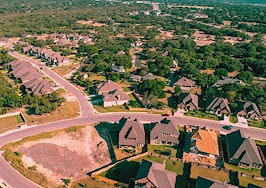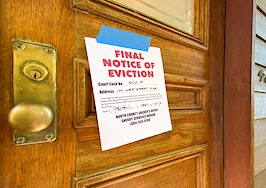If the scorching-hot housing market has an epicenter, it’s probably California.
The market may heat up a little more slowly in the second half of the year, but it’s still predicted to end the year with an eye-popping jump in home prices, according to a forecast from the California Association of Realtors.
In a webinar last week, the more than 200,000-member trade group’s research and economics team noted that while housing had been a bright spot in the economy during the coronavirus pandemic, the market’s structural challenges have become worse, namely, lack of supply amid ever-rising homebuyer demand.
During the pandemic, the four lowest-paid sectors of the economy — leisure/hospitality, other services, retail trade and administrative support — lost the biggest percentage of jobs while the higher-paying information, management, financial activities and professional services sectors lost comparatively fewer jobs and therefore were more insulated from the recession, according to Jordan Levine, vice president and chief economist at C.A.R.
So as the importance of home and the desire for more space increased during the pandemic, these potential homebuyers were therefore in a better position to take advantage of low mortgage rates and jump into the market, he said.
Last month, C.A.R. reported that year-to-date statewide home sales were up 33.6 percent in June and the statewide median home price hit a record high of $819,630, up 0.2 percent from May and up 30.9 percent from June 2020. Unsold inventory stood at 1.7 months, down 37 percent year over year.
“That growth comes despite the fact that we’re at very, very tight levels of inventory still,” Levine said. “In fact, I would argue that we would have been selling more homes up to this point, but for the fact that we have so many buyers and just not enough homes to put them in. That’s one of the reasons why the market you see out there is still incredibly competitive from the standpoint of buyers.”
The median number of days it took to sell a single-family home in California in June was eight days, compared to 19 days in June 2020. Nearly three-quarters of homes are closing at above asking price, according to C.A.R.
While vacation destinations saw a rise in sales activity during the pandemic, “demand is returning to California’s core,” according to Levine. Condo sales, which were hit hard during the pandemic initially, are also starting to come back, he added.
“The two areas that are growing fastest right now in terms of closed transactions are the San Francisco Bay Area and Southern California, where most of the folks in California actually live,” he said.
First-time buyers are relatively affluent compared to their peers more than a decade ago. About a third, 33.1 percent, bought with a 20 percent or more down payment in 2020, compared to 23.9 percent in 2006 during the height of the pre-Great Recession housing bubble. The median down payment last year for first-timers was 10 percent, compared to 2.4 percent in 2006 when nearly 41 percent of first-timers bought with no down payment at all.
In California, the homeownership rate was 54.9 percent in 2019, below the 64.2 percent rate for the U.S. overall. The rate is even lower for people of color in the state and the supply crisis is exacerbating the problem, according to Levine.

Source: California Association of Realtors
“We have all these negative records in terms of not building enough — second-worst in the nation — that lead to all these terrible consequences from the standpoint of the housing market with low vacancy rates, low housing inventory on the for-sale market, record high prices,” he said.
“But more importantly what those things translate to in terms of the quality of life, because we’re the second-worst state in the nation when it comes to rent-burdened households — that’s households that spend too much of their income just covering rent. We’re the second worst state in the nation when it comes to overcrowding — too many people being crammed in because housing is so unaffordable — and when you look at the supplemental poverty estimates — the ones that actually account for the cost of housing — California is dead last.
“You don’t have to look much farther than our lack of supply and those are some of the things that are still going to be around and those things haven’t changed and ultimately are the things that are really driving us to see more folks leave the state.”
Regarding new listings for existing single-family homes, Oscar Wei, C.A.R.’s deputy chief economist, offered a cautious glimmer of optimism. “On a monthly basis, new active listings are actually improving a little bit,” rising 7.8 percent year over year in June, he said. Still, compared to before the pandemic, listings are down about 15 percent, he added.
“So there’s definitely more room to improve,” he said. “It is going to continue to improve, but also it is not going to be [at] a fast pace, and we all know that housing supply issue is not going to be something that can be corrected overnight.”
Pending sales declined 11 percent in June — the first dip since May 2020 — and C.A.R. expects that sales will slow in the latter half of the year, but remain solid, ending the year with 444,500 sales — 7.9 percent higher than in 2020. Active listings will continue to decline, but at a slower pace than in the first half of the year, in part due to higher mortgage rates and buyer fatigue, according to the trade group.
C.A.R. also expects the median sales price of existing single-family homes will continue to rise year over year and end up 20.7 percent higher than in 2020, at a median $795,600.

Source: C.A.R.
“Of course, with that high level of price, you’re also seeing a drop off in housing affordability,” Wei said. “Based on our housing affordability index, only about 25 percent of all households in California in 2021 could afford to buy a median-priced home. If you flip it around, it means 75 percent of all households in California cannot afford to buy a median-priced home, even though we have a [mortgage] rate at 3 percent for the year as a whole.
“That’s still a tough pill to swallow, and hopefully in the upcoming years, we’ll have more improvement in supply.”
C.A.R. will release its 2022 forecast in October.













